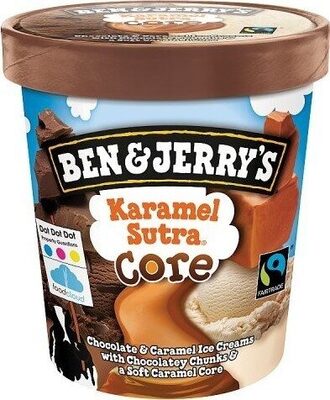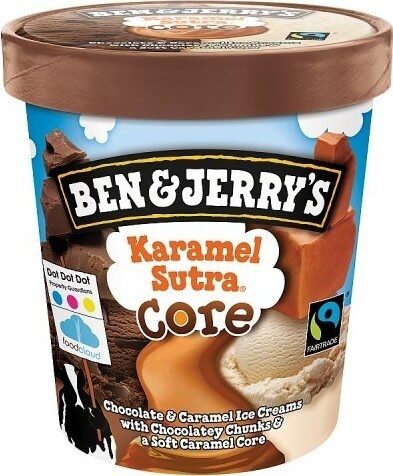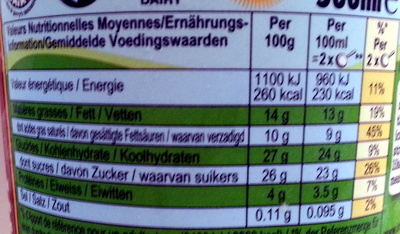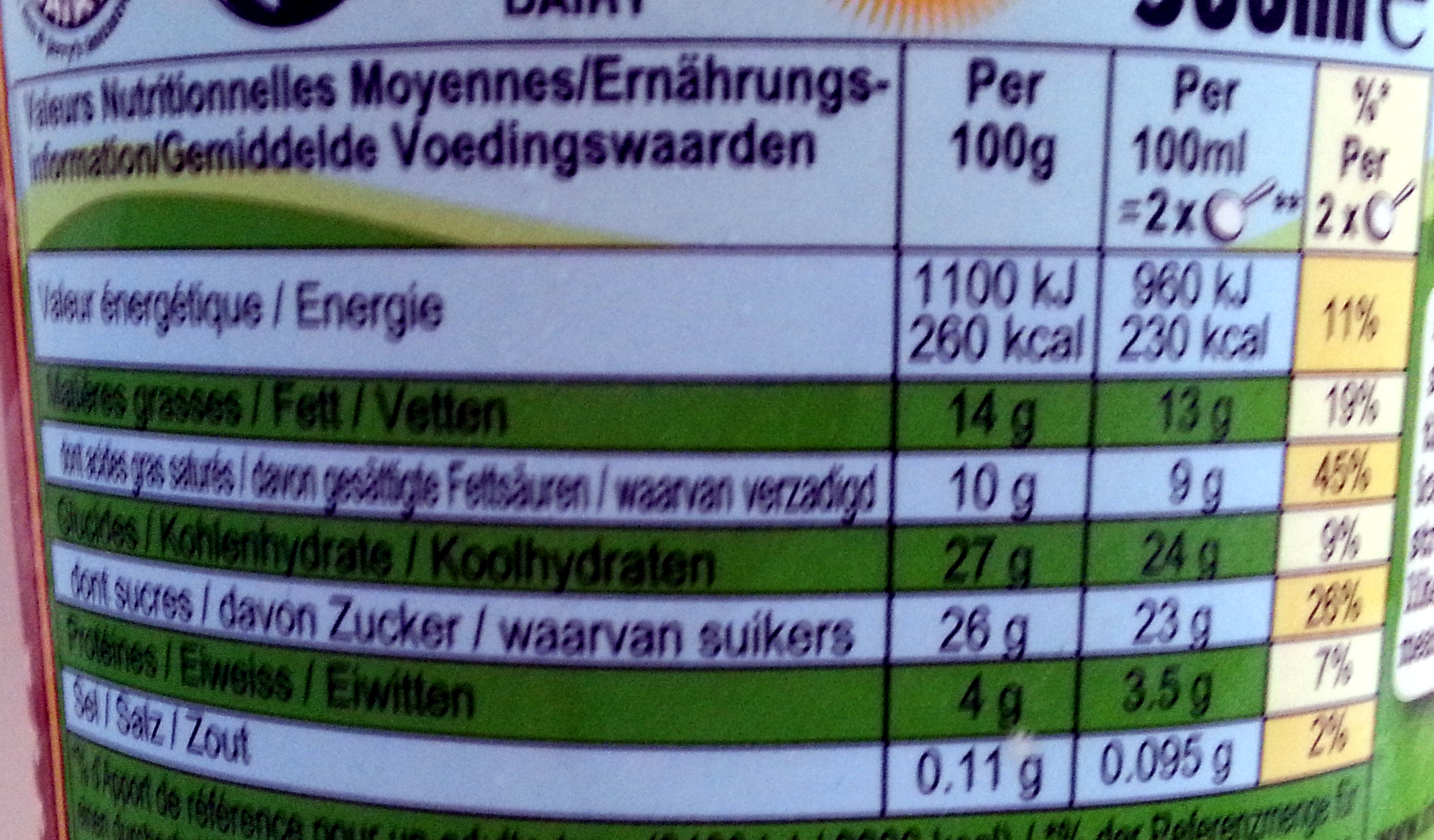Help us make food transparency the norm!
As a non-profit organization, we depend on your donations to continue informing consumers around the world about what they eat.
The food revolution starts with you!
Jerry's Karamel Sutra Ice Cream - Ben & Jerry's - 430 g, 500 ml
Jerry's Karamel Sutra Ice Cream - Ben & Jerry's - 430 g, 500 ml
This product page is not complete. You can help to complete it by editing it and adding more data from the photos we have, or by taking more photos using the app for Android or iPhone/iPad. Thank you!
×
Streckkod: 8712566934744 (EAN / EAN-13)
Vanligt namn: Un cœur de sauce caramel (12%) entouré de crèmes glacées chocolat et caramel avec des pépites cacaotées (4%)
Kvantitet: 430 g, 500 ml
Förpackning: en:Pot, Kartong, en:Frozen, fr:Green dot, fr:Pot et couvercle en carton
Varumärken: Ben & Jerry's
Kategorier: Efterrätter, Fryst mat, Frysta efterrätter, Glass och sorbet, Glass, Glassbyttor
Etiketter, certifieringar, utmärkelser:
Fair trade, Fairtrade International, Kosher, Kof-K, fr:Caring dairy


Tillverknings eller bearbetningsplats: Netherlands
Länk till produktsidan på producentens officiella webbplats: http://www.benjerry.nl
Butiker: Auchan, Leader Price
Länder där såld: Österrike, Belgien, Frankrike, Tyskland, Nederländerna, Sverige, Schweiz
Matching with your preferences
Hälsa
Ingredienser
-
23 ingredienser
: Crème (26%), eau, LAIT concentré écrémé, sucre, LAIT concentré entier sucré, sirop de glucose, poudre de cacao, jaune d'ŒUF, huile de coco, cacao maigre en poudre, matière grasse du LAIT, stabilisants (gomme guar, carraghénanes, pectines), sel, émulsifiants (lécithine de SOJA, lécithine de tournesol), extrait de vanille, correcteurs d'acidité (carbonates de sodium, acide citrique).Allergener: Ägg, Mjölk, Soja
Food processing
-
Ultra processed foods
Elements that indicate the product is in the 4 - Ultra bearbetade livsmedel och drycker group:
- Tillsats: E322 - Lecitiner
- Tillsats: E407 - Karragenan
- Tillsats: E412 - Guarkärnmjöl
- Tillsats: E440 - Pektiner
- Ingrediens: Emulgeringsmedel
- Ingrediens: Glukos
- Ingrediens: Glukossirap
Food products are classified into 4 groups according to their degree of processing:
- Obearbetade eller minimalt bearbetade livsmedel
- Bearbetade kulinariska ingredienser
- Halvfabrikat
- Ultra processed foods
The determination of the group is based on the category of the product and on the ingredients it contains.
Tillsatser
-
E322 - Lecitiner
Lecithin: Lecithin -UK: , US: , from the Greek lekithos, "egg yolk"- is a generic term to designate any group of yellow-brownish fatty substances occurring in animal and plant tissues, which are amphiphilic – they attract both water and fatty substances -and so are both hydrophilic and lipophilic-, and are used for smoothing food textures, dissolving powders -emulsifying-, homogenizing liquid mixtures, and repelling sticking materials.Lecithins are mixtures of glycerophospholipids including phosphatidylcholine, phosphatidylethanolamine, phosphatidylinositol, phosphatidylserine, and phosphatidic acid.Lecithin was first isolated in 1845 by the French chemist and pharmacist Theodore Gobley. In 1850, he named the phosphatidylcholine lécithine. Gobley originally isolated lecithin from egg yolk—λέκιθος lekithos is "egg yolk" in Ancient Greek—and established the complete chemical formula of phosphatidylcholine in 1874; in between, he had demonstrated the presence of lecithin in a variety of biological matters, including venous blood, in human lungs, bile, human brain tissue, fish eggs, fish roe, and chicken and sheep brain. Lecithin can easily be extracted chemically using solvents such as hexane, ethanol, acetone, petroleum ether, benzene, etc., or extraction can be done mechanically. It is usually available from sources such as soybeans, eggs, milk, marine sources, rapeseed, cottonseed, and sunflower. It has low solubility in water, but is an excellent emulsifier. In aqueous solution, its phospholipids can form either liposomes, bilayer sheets, micelles, or lamellar structures, depending on hydration and temperature. This results in a type of surfactant that usually is classified as amphipathic. Lecithin is sold as a food additive and dietary supplement. In cooking, it is sometimes used as an emulsifier and to prevent sticking, for example in nonstick cooking spray.Källa: Wikipedia (Engelska)
-
E322i - Lecitin
Lecithin: Lecithin -UK: , US: , from the Greek lekithos, "egg yolk"- is a generic term to designate any group of yellow-brownish fatty substances occurring in animal and plant tissues, which are amphiphilic – they attract both water and fatty substances -and so are both hydrophilic and lipophilic-, and are used for smoothing food textures, dissolving powders -emulsifying-, homogenizing liquid mixtures, and repelling sticking materials.Lecithins are mixtures of glycerophospholipids including phosphatidylcholine, phosphatidylethanolamine, phosphatidylinositol, phosphatidylserine, and phosphatidic acid.Lecithin was first isolated in 1845 by the French chemist and pharmacist Theodore Gobley. In 1850, he named the phosphatidylcholine lécithine. Gobley originally isolated lecithin from egg yolk—λέκιθος lekithos is "egg yolk" in Ancient Greek—and established the complete chemical formula of phosphatidylcholine in 1874; in between, he had demonstrated the presence of lecithin in a variety of biological matters, including venous blood, in human lungs, bile, human brain tissue, fish eggs, fish roe, and chicken and sheep brain. Lecithin can easily be extracted chemically using solvents such as hexane, ethanol, acetone, petroleum ether, benzene, etc., or extraction can be done mechanically. It is usually available from sources such as soybeans, eggs, milk, marine sources, rapeseed, cottonseed, and sunflower. It has low solubility in water, but is an excellent emulsifier. In aqueous solution, its phospholipids can form either liposomes, bilayer sheets, micelles, or lamellar structures, depending on hydration and temperature. This results in a type of surfactant that usually is classified as amphipathic. Lecithin is sold as a food additive and dietary supplement. In cooking, it is sometimes used as an emulsifier and to prevent sticking, for example in nonstick cooking spray.Källa: Wikipedia (Engelska)
-
E330 - Citronsyra
Citric acid: Citric acid is a weak organic acid that has the chemical formula C6H8O7. It occurs naturally in citrus fruits. In biochemistry, it is an intermediate in the citric acid cycle, which occurs in the metabolism of all aerobic organisms. More than a million tons of citric acid are manufactured every year. It is used widely as an acidifier, as a flavoring and chelating agent.A citrate is a derivative of citric acid; that is, the salts, esters, and the polyatomic anion found in solution. An example of the former, a salt is trisodium citrate; an ester is triethyl citrate. When part of a salt, the formula of the citrate ion is written as C6H5O3−7 or C3H5O-COO-3−3.Källa: Wikipedia (Engelska)
-
E407 - Karragenan
Carrageenan: Carrageenans or carrageenins - karr-ə-gee-nənz, from Irish carraigín, "little rock"- are a family of linear sulfated polysaccharides that are extracted from red edible seaweeds. They are widely used in the food industry, for their gelling, thickening, and stabilizing properties. Their main application is in dairy and meat products, due to their strong binding to food proteins. There are three main varieties of carrageenan, which differ in their degree of sulfation. Kappa-carrageenan has one sulfate group per disaccharide, iota-carrageenan has two, and lambda-carrageenan has three. Gelatinous extracts of the Chondrus crispus -Irish moss- seaweed have been used as food additives since approximately the fifteenth century. Carrageenan is a vegetarian and vegan alternative to gelatin in some applications or may be used to replace gelatin in confectionery.Källa: Wikipedia (Engelska)
-
E412 - Guarkärnmjöl
Guar gum: Guar gum, also called guaran, is a galactomannan polysaccharide extracted from guar beans that has thickening and stabilizing properties useful in the food, feed and industrial applications. The guar seeds are mechanically dehusked, hydrated, milled and screened according to application. It is typically produced as a free-flowing, off-white powder.Källa: Wikipedia (Engelska)
-
E440 - Pektiner
Pectin: Pectin -from Ancient Greek: πηκτικός pēktikós, "congealed, curdled"- is a structural heteropolysaccharide contained in the primary cell walls of terrestrial plants. It was first isolated and described in 1825 by Henri Braconnot. It is produced commercially as a white to light brown powder, mainly extracted from citrus fruits, and is used in food as a gelling agent, particularly in jams and jellies. It is also used in dessert fillings, medicines, sweets, as a stabilizer in fruit juices and milk drinks, and as a source of dietary fiber.Källa: Wikipedia (Engelska)
-
E500 - Natriumkarbonater
Sodium carbonate: Sodium carbonate, Na2CO3, -also known as washing soda, soda ash and soda crystals, and in the monohydrate form as crystal carbonate- is the water-soluble sodium salt of carbonic acid. It most commonly occurs as a crystalline decahydrate, which readily effloresces to form a white powder, the monohydrate. Pure sodium carbonate is a white, odorless powder that is hygroscopic -absorbs moisture from the air-. It has a strongly alkaline taste, and forms a moderately basic solution in water. Sodium carbonate is well known domestically for its everyday use as a water softener. Historically it was extracted from the ashes of plants growing in sodium-rich soils, such as vegetation from the Middle East, kelp from Scotland and seaweed from Spain. Because the ashes of these sodium-rich plants were noticeably different from ashes of timber -used to create potash-, they became known as "soda ash". It is synthetically produced in large quantities from salt -sodium chloride- and limestone by a method known as the Solvay process. The manufacture of glass is one of the most important uses of sodium carbonate. Sodium carbonate acts as a flux for silica, lowering the melting point of the mixture to something achievable without special materials. This "soda glass" is mildly water-soluble, so some calcium carbonate is added to the melt mixture to make the glass produced insoluble. This type of glass is known as soda lime glass: "soda" for the sodium carbonate and "lime" for the calcium carbonate. Soda lime glass has been the most common form of glass for centuries. Sodium carbonate is also used as a relatively strong base in various settings. For example, it is used as a pH regulator to maintain stable alkaline conditions necessary for the action of the majority of photographic film developing agents. It acts as an alkali because when dissolved in water, it dissociates into the weak acid: carbonic acid and the strong alkali: sodium hydroxide. This gives sodium carbonate in solution the ability to attack metals such as aluminium with the release of hydrogen gas.It is a common additive in swimming pools used to raise the pH which can be lowered by chlorine tablets and other additives which contain acids. In cooking, it is sometimes used in place of sodium hydroxide for lyeing, especially with German pretzels and lye rolls. These dishes are treated with a solution of an alkaline substance to change the pH of the surface of the food and improve browning. In taxidermy, sodium carbonate added to boiling water will remove flesh from the bones of animal carcasses for trophy mounting or educational display. In chemistry, it is often used as an electrolyte. Electrolytes are usually salt-based, and sodium carbonate acts as a very good conductor in the process of electrolysis. In addition, unlike chloride ions, which form chlorine gas, carbonate ions are not corrosive to the anodes. It is also used as a primary standard for acid-base titrations because it is solid and air-stable, making it easy to weigh accurately.Källa: Wikipedia (Engelska)
Ingrediensanalys
-
Kan innehålla palmolja
Ingredienser som kan innehålla palmolja: Mjölkfett
-
Icke-vegan
Non-vegan ingredients: Grädde, Kondenserad skummjölk, en:Sweetened condensed whole milk, Äggula, Mjölkfett
-
Vegetariskt
No non-vegetarian ingredients detected
-
Details of the analysis of the ingredients
: Crème 26%, eau, LAIT concentré écrémé, sucre, LAIT concentré entier sucré, sirop de glucose, poudre de cacao, jaune d'_ŒUF_, huile de coco, cacao maigre en poudre, matière grasse du LAIT, stabilisants (gomme guar, carraghénanes, pectines), sel, émulsifiants (lécithine de SOJA, lécithine de tournesol), extrait de vanille, correcteurs d'acidité (carbonates de sodium, acide citrique)- Crème -> en:cream - vegan: no - vegetarian: yes - ciqual_food_code: 19402 - percent_min: 26 - percent: 26 - percent_max: 26
- eau -> en:water - vegan: yes - vegetarian: yes - ciqual_food_code: 18066 - percent_min: 4.93333333333333 - percent_max: 26
- LAIT concentré écrémé -> en:condensed-skimmed-milk - vegan: no - vegetarian: yes - ciqual_proxy_food_code: 19051 - percent_min: 3.42857142857143 - percent_max: 26
- sucre -> en:sugar - vegan: yes - vegetarian: yes - ciqual_proxy_food_code: 31016 - percent_min: 1.69230769230769 - percent_max: 25
- LAIT concentré entier sucré -> en:sweetened-condensed-whole-milk - vegan: no - vegetarian: yes - ciqual_food_code: 19027 - percent_min: 0 - percent_max: 20
- sirop de glucose -> en:glucose-syrup - vegan: yes - vegetarian: yes - ciqual_proxy_food_code: 31016 - percent_min: 0 - percent_max: 16.6666666666667
- poudre de cacao -> en:cocoa-powder - vegan: yes - vegetarian: yes - ciqual_food_code: 18100 - percent_min: 0 - percent_max: 13.4748717948718
- jaune d'_ŒUF_ -> en:egg-yolk - vegan: no - vegetarian: yes - ciqual_food_code: 22002 - percent_min: 0 - percent_max: 11.2290598290598
- huile de coco -> en:coconut-oil - vegan: yes - vegetarian: yes - from_palm_oil: no - ciqual_food_code: 16040 - percent_min: 0 - percent_max: 9.62490842490842
- cacao maigre en poudre -> en:fat-reduced-cocoa-powder - vegan: yes - vegetarian: yes - ciqual_food_code: 18100 - percent_min: 0 - percent_max: 8.42179487179487
- matière grasse du LAIT -> en:milkfat - vegan: no - vegetarian: yes - from_palm_oil: maybe - percent_min: 0 - percent_max: 7.48603988603989
- stabilisants -> en:stabiliser - percent_min: 0 - percent_max: 6.7374358974359
- gomme guar -> en:e412 - vegan: yes - vegetarian: yes - percent_min: 0 - percent_max: 6.7374358974359
- carraghénanes -> en:e407 - vegan: yes - vegetarian: yes - percent_min: 0 - percent_max: 3.36871794871795
- pectines -> en:e440a - vegan: yes - vegetarian: yes - percent_min: 0 - percent_max: 2.24581196581197
- sel -> en:salt - vegan: yes - vegetarian: yes - ciqual_food_code: 11058 - percent_min: 0 - percent_max: 0.11
- émulsifiants -> en:emulsifier - percent_min: 0 - percent_max: 0.11
- lécithine de SOJA -> en:soya-lecithin - vegan: yes - vegetarian: yes - ciqual_food_code: 42200 - percent_min: 0 - percent_max: 0.11
- lécithine de tournesol -> en:sunflower-lecithin - vegan: yes - vegetarian: yes - percent_min: 0 - percent_max: 0.11
- extrait de vanille -> en:vanilla-extract - vegan: yes - vegetarian: yes - ciqual_food_code: 11065 - percent_min: 0 - percent_max: 0.11
- correcteurs d'acidité -> en:acidity-regulator - percent_min: 0 - percent_max: 0.11
- carbonates de sodium -> en:e500 - vegan: yes - vegetarian: yes - percent_min: 0 - percent_max: 0.11
- acide citrique -> en:e330 - vegan: yes - vegetarian: yes - percent_min: 0 - percent_max: 0.11
Näring
-
Poor nutritional quality
⚠ ️Varning: mängden fibrer är inte angiven, eventuella positiv inverkan på betyget kunde inte beaktas.⚠ ️Warning: the amount of fruits, vegetables and nuts is not specified on the label, it was estimated from the list of ingredients: 0This product is not considered a beverage for the calculation of the Nutri-Score.
Positiva poäng: 0
- Proteiner: 2 / 5 (värde: 4, avrundat värde: 4)
- Fiber: 0 / 5 (värde: 0, avrundat värde: 0)
- Frukt, grönsaker, nötter och raps- / valnöt- / olivoljor: 0 / 5 (värde: 0, avrundat värde: 0)
Negativa poäng: 17
- Energi: 3 / 10 (värde: 1100, avrundat värde: 1100)
- Socker: 5 / 10 (värde: 26, avrundat värde: 26)
- Mättat fett: 9 / 10 (värde: 10, avrundat värde: 10)
- Natrium: 0 / 10 (värde: 44, avrundat värde: 44)
The points for proteins are not counted because the negative points are greater or equal to 11.
Näringsvärde: (17 - 0)
Nutri-Score:
-
Näringsvärden
-
Fett i måttlig kvantitet (14%)
What you need to know- A high consumption of fat, especially saturated fats, can raise cholesterol, which increases the risk of heart diseases.
Recommendation: Limit the consumption of fat and saturated fat- Choose products with lower fat and saturated fat content.
-
Mättat fett i hög kvantitet (10%)
What you need to know- A high consumption of fat, especially saturated fats, can raise cholesterol, which increases the risk of heart diseases.
Recommendation: Limit the consumption of fat and saturated fat- Choose products with lower fat and saturated fat content.
-
Sockerarter i hög kvantitet (26%)
What you need to know- A high consumption of sugar can cause weight gain and tooth decay. It also augments the risk of type 2 diabetes and cardio-vascular diseases.
Recommendation: Limit the consumption of sugar and sugary drinks- Sugary drinks (such as sodas, fruit beverages, and fruit juices and nectars) should be limited as much as possible (no more than 1 glass a day).
- Choose products with lower sugar content and reduce the consumption of products with added sugars.
-
Salt i låg kvantitet (0.11%)
What you need to know- A high consumption of salt (or sodium) can cause raised blood pressure, which can increase the risk of heart disease and stroke.
- Many people who have high blood pressure do not know it, as there are often no symptoms.
- Most people consume too much salt (on average 9 to 12 grams per day), around twice the recommended maximum level of intake.
Recommendation: Limit the consumption of salt and salted food- Reduce the quantity of salt used when cooking, and don't salt again at the table.
- Limit the consumption of salty snacks and choose products with lower salt content.
-
-
Näringsfakta
Näringsfakta Som såld
för 100 g / 100 mlSom såld
per portion (100 ml, 86 g, 2 scoops)Compared to: Glassbyttor Energi 1 100 kj
(260 kcal)1 100 kj
(260 kcal)+24 % Fett 14 g 14 g +32 % Mättat fett 10 g 10 g +47 % Kolhydrat 27 g 27 g +6 % Sockerarter 26 g 26 g +14 % Fiber ? ? Protein 4 g 4 g +17 % Salt 0,11 g 0,11 g −39 % Fruits‚ vegetables‚ nuts and rapeseed‚ walnut and olive oils (estimate from ingredients list analysis) 0 % 0 %
Miljö
-
Eco-Score A - Mycket låg miljöpåverkan
The Eco-Score is an experimental score that summarizes the environmental impacts of food products.→ The Eco-Score was initially developped for France and it is being extended to other European countries. The Eco-Score formula is subject to change as it is regularly improved to make it more precise and better suited to each country.Life cycle analysis
-
Average impact of products of the same category: A (Score: 87/100)
Kategori: Ice cream, cone (normal size)
Kategori: Ice cream, cone (normal size)
- PEF environmental score: 0.22 (the lower the score, the lower the impact)
- including impact on climate change: 1.75 kg CO2 eq/kg of product
Stage Impact Jordbruk
56.9 %Bearbetar
18.1 %Förpackning
6.7 %Transportation
6.9 %Distribution
7.2 %Consumption
4.2 %
Bonuses and maluses
-
Labels with environmental benefits
Bonus: +10
-
Fairtrade International
Fair trade is an arrangement designed to help producers in developing countries achieve sustainable and equitable trade relationships. Members of the fair trade movement add the payment of higher prices to exporters, as well as improved social and environmental standards.
-
-
Missing origins of ingredients information
Malus: -5
⚠ ️ The origins of the ingredients of this product are not indicated.
If they are indicated on the packaging, you can modify the product sheet and add them.
If you are the manufacturer of this product, you can send us the information with our free platform for producers.
-
Packaging with a medium impact
Malus: -10
Form Material Återvinning Impact Lid Kartong Låg Pot Okänd Hög ⚠ ️ The information about the packaging of this product is not sufficiently precise (exact shapes and materials of all components of the packaging).⚠ ️ For a more precise calculation of the Eco-Score, you can modify the product page and add them.
If you are the manufacturer of this product, you can send us the information with our free platform for producers.
Eco-Score for this product
-
Impact for this product: A (Score: 82/100)
Produkt: Jerry's Karamel Sutra Ice Cream - Ben & Jerry's - 430 g, 500 ml
Life cycle analysis score: 87
Sum of bonuses and maluses: -5
Final score: 82/100
-
Carbon footprint
-
Equal to driving 0.9 km in a petrol car
175 g CO² per 100g of product
The carbon emission figure comes from ADEME's Agribalyse database, for the category: Ice cream, cone (normal size) (Source: ADEME Agribalyse Database)
Stage Impact Jordbruk
61.0 %Bearbetar
12.3 %Förpackning
10.3 %Transportation
11.3 %Distribution
3.7 %Consumption
1.4 %
Förpackning
-
Packaging with a medium impact
-
Packaging parts
Lid (Kartong)
Pot
-
Packaging materials
Material % Packaging weight Packaging weight per 100 g of product Paper or cardboard
-
Transportation
-
Origins of ingredients
Missing origins of ingredients information
⚠ ️ The origins of the ingredients of this product are not indicated.
If they are indicated on the packaging, you can modify the product sheet and add them.
If you are the manufacturer of this product, you can send us the information with our free platform for producers.Add the origins of ingredients for this product Add the origins of ingredients for this product
Etiketter
-
Fairtrade International
Fair trade is an arrangement designed to help producers in developing countries achieve sustainable and equitable trade relationships. Members of the fair trade movement add the payment of higher prices to exporters, as well as improved social and environmental standards.
Report a problem
-
Incomplete or incorrect information?
Category, labels, ingredients, allergens, nutritional information, photos etc.
If the information does not match the information on the packaging, please complete or correct it. Open Food Facts is a collaborative database, and every contribution is useful for all.
Datakällor
Produkt tillagd den av openfoodfacts-contributors
Senast ändrad produktsida på av packbot.
Produktsida också redigerad av aleene, date-limite-app, foodrepo, jeanbono, kiliweb, musarana, olofolleola4, openfood-ch-import, smias, tacite, yuka.sY2b0xO6T85zoF3NwEKvlkdaT_yCp22baxn5x2fT996lcK7KffJ2s432N6s.












